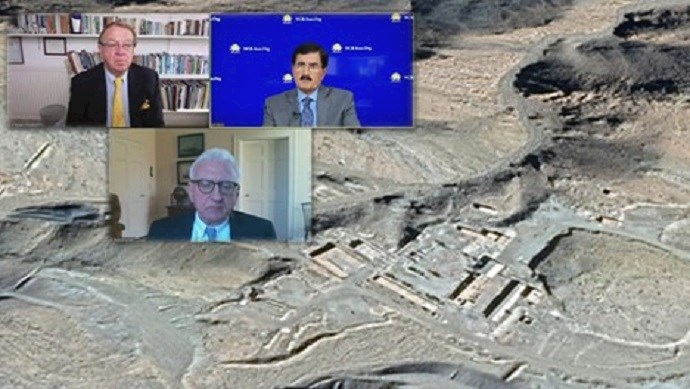Reporting by PMOI/MEK
Iran, March 3, 2021—In an online conference held on Tuesday, the National Council of Resistance of Iran (NCRI) revealed information about a nuclear site that the Iranian regime has been hiding from the International Atomic Energy Agency (IAEA). The site, located in the Abadeh, Fars province, is one of two locations that the regime had denied to IAEA inspectors for months. The NCRI’s revelation comes at a time that IAEA inspectors found traces of uranium enrichment activities at the sites and IAEA director Rafael Grossi has expressed deep concerns on the finding of undeclared nuclear material in undeclared locations in Iran.
The information was obtained through the network of the People’s Mojahedin Organization of Iran (PMOI/MEK) inside Iran.
The site in question was built under the supervision of Revolutionary Guards (IRGC) contractor companies in the mid-1990s, and is part of a project managed by SPND, the main entity in charge of research and development of nuclear weapons.
The Abadeh site is involved in the Marivan project, an initiative led by SPND subsidiary METFAZ, which is engaged in the research and construction of nuclear high-explosive detonators.
The Marivan project is overseen by Dr. Saeed Borji, one of the regime’s top explosives and high-impact specialists.
Front companies
Online conference : #Iran regime’s #nuclear weapons program | New information on an undeclared site where #IAEA found uranium particles https://t.co/WQ6JkU9eDe
— NCRI-FAC (@iran_policy) March 1, 2021
“According to credible intelligence, [Borji] and some other senior SPND experts have formed front companies to conduct their research to advance SPND’s objectives,” NCRI representative Ali Safavi said during Tuesday’s conference.
Among these front companies is the Azar Afrooz Saeed LLC, which builds spherical tanks that are shaped to explode quite similar to explosions used in nuclear weapons detonator experiments.
“Saeed Borji’s position in this company is Vice Chairman of the Board,” Safavi said.
Also in the picture is Akbar Motalebizadeh, an explosives specialist and senior manager of SPND, who along with several others established the Arvin Kimia Abzar Company in Tehran in March 2019.
“This front company is involved in the production, purchase, sale, export and import of tools and materials used in the drilling and operation of oil wells. Saeed Borji is the chairman of the board and Akbar Motalebizadeh is the managing director of this company,” According to Safavi.
A third company, Parsian Asr Arvin Private Stock Company, which was established in Tehran in December 2015, is active in “commercial activities and services for the production, purchase, sale, export, and import of tools and materials used in the oil industry, drilling and operation of oil wells.”
Interestingly, Parsian Asr Arvin’s headquarters were located very close to the main offices of SPND in Tehran. The company was dissolved in March 2018.
“It is worth noting that in response to the IAEA’s inquiry into the detonation of multiple explosives at the same time, which had dual-use in connection with the explosion of nuclear weapons (EBW), the mullahs’ regime falsely claimed that it needs the technology to operate oil wells,” Safavi said in his remarks.
The regime is using these and possibly other companies to continue pursuing nuclear weapons research and development secretly.
Sanitization of nuclear activities

Abadeh nuclear facility, Fars province
In July 2019, the IRGC realized that the Abadeh site had been exposed. It began a complete sanitization of the area to destroy all traces of activity. The buildings and facilities were completely demolished. The regime only made the site accessible to inspectors one year later in August 2020.
The process to sanitize the site was very similar to processes implemented in Shian-Lavizan in 2004 as well as a part of the Parchin site in 2012, where there was a special explosive chamber, Safavi said.
The NCRI exposed the Shian-Lavizan site, located in northeastern Tehran, in May 2003. The IAEA requested to visit the site. The regime razed the site before providing access to IAEA inspector. When Agency inspectors arrived in 2004, up to four meters of soil was turned over.
The Parchin military complex, set up in early 2000s in southeastern Tehran, contained an explosive chamber to test powerful explosions related to the production of nuclear weapons. When the IAEA requested to visit the site in 2012, the regime began a complete clean-up of the area in Parchin. The Agency finally gained access to this part of Parchin in 2015.
The nuclear weapons policy
“The fact is that the mullahs’ regime is seeking to acquire nuclear weapons as a strategic means to guarantee its survival, and for this reason, it has never abandoned its pursuit of a nuclear weapon. This pursuit has continued unabated for the past three decades,” Safavi said.
Over the past two decades, the NCRI has made more than 100 revelations on the different aspects of the Iranian regime’s nuclear program. Nuclear weapons are a vital part of the mullahs’ regime’s strategy for survival, especially as they are faced with increasing unrest at home and isolation abroad.
“It is naïve to think that by providing concessions or overlooking its violations, the regime, will change its behavior. This has not happened and will never happen. A leopard never changes spots,” Safavi said.





